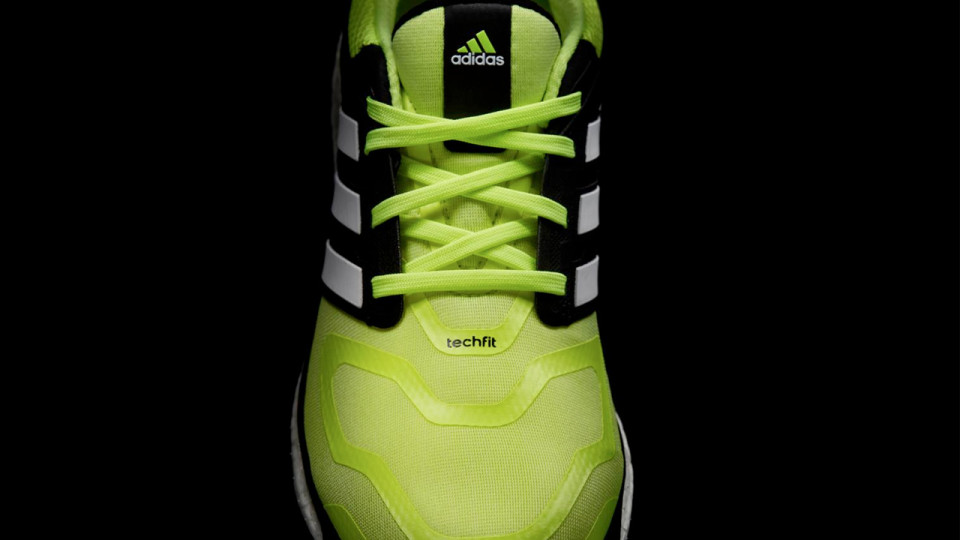The future is now! Or at least, that’s what adidas has been saying about their new shoe, the adidas BOOST™ before its release in February this year. Its highly touted new BOOST™ foam midsole is made up of hundreds of tiny capsules instead of one solid piece of foam which allegedly returns energy back to the runner every time your foot strikes the ground. It has led adidas to market the Boosts as the “running shoe that revolutionised the running world”. According to the adidas performance labs, the BOOST™ sole not only returns energy to the runner, whatever that may truly mean, but it actually causes a runner to use less oxygen when running compared to the industry standard foam soles, EVA. After several months on the market, adidas has seen the Boost’s performance results confirmed time and time again by veteran and rookie runners alike in numerous Boost shoe reviews, and have turned the current “less is more” trend in running on its head. With the adidas Boosts, adidas hopes to increase its paltry 5.8% market share (according to Forbes) in the athletic shoes market and challenge Nike for the mantle of “best running shoe”.
First Impressions
After picking up a pair of the adidas Boosts, I was pleased to discover that the colour options have finally opened up beyond the bland black and flashy neon yellow option (my favourite). When trying them on, the Techfit™ upper made a significant impact on the weight, while still supporting my foot. The white Boost sole is a concern of mine. It got dirtied up almost immediately when stepping outside, and this could create some issues for people looking for a walking shoe that will stay attractive.

As I mentioned earlier, the shoe is truly revolutionary as most shoe companies have leaned towards creating shoes that mimic running barefoot, making minimalism the current trend. It has been awhile since my running shoes have had this much drop, but it didn’t feel awkward like it does in most shoes with such a high drop thanks to the springy Boost midsole.

I took them out for an easy 5km run to really get a feel of the difference the Boost midsole provided, and it was exhilarating. The sole did exactly what was advertised and made my little jog a breeze, adding a little extra oomph to my run and actually shaving off a few seconds from my average time. For once, I was actually so comfortable in my running shoes that I didn’t realise that I was maintaining such a brisk pace. I also decided to change up my strike to see just how the shoe works for heel strikers and found that the BOOST™ technology actually springs the foot up better. It makes this shoe the Holy Grail for heel strikers looking for relief. It also helps to mention that the shoes remained comfortable and cool despite it being a sunny 30 degrees during my run.

If I had any real concerns about the comfort of what could be arguably the most comfortable shoe on the market, it would be the seeming lack of support in the Torsion portion of the Boost. Generally, running shoes are torsionally stiff where sprinting shoes need to be flexible to accommodate a quickly changing foot shape. I would prefer more support in the Torsion areas, but this by no means makes the Energy Boost any less exciting in my book.
When it really comes down to it, if a running shoe doesn’t feel good then it isn’t worth the purchase. There can be a hundred bells and whistles, but if your feet are left sore and throbbing after an intermediate run, a running shoe has little to no value to a dedicate runner. Luckily for adidas, they have created a shoe that above all feels great, but also looks pretty amazing as well (other than the white soles that dirty ever-so-quickly). My 5km time proved to me that the Energy Boost’s proprietary technologies do make a difference, and I won’t bother citing the numerous pseudo-scientific studies that the adidas marketing department has floated out into the running world. Another great aspect of the shoe, as I mentioned, is a particular comfort advantage for heel strikers and would make an excellent trainer for those with that particular gait.
Runner’s Boon
- Light
- Comfortable
- Extra ‘energy’ for heel strikers
Runner’s Bane
- Unattractive soles
- Pricey
- Torsion system is less supportive
Ultimately, adidas has made a quality shoe and it almost justifies the hefty $239 price tag. The newest gadgets and gizmos come with a premium and the Energy Boost is no different. Still, I would be surprised if the success of the Energy Boost doesn’t see the BOOST sole implemented in more economical trainers. Well, that’s all for my Boost shoe review, and now I’m going to pound some more pavement!





